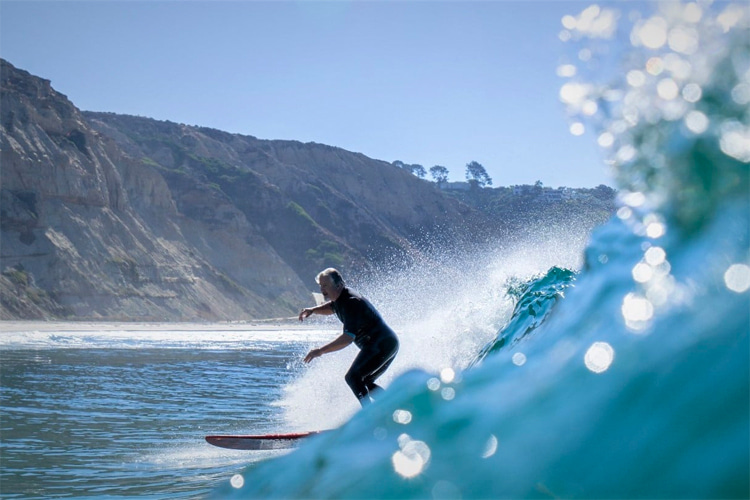I walked down to the beach that day. Not unusual in and of itself - but annoying nonetheless. A ride down would have afforded me more time in the water.
There was a dearth of cars parked near the university on the bluff above, and this was either a good thing - as my timing might fall between crowd shifts - or a bad thing, as the wave quality might be lacking.
The latter possibility is an exercise in futility.
The University of California owned the only access road to the beach, and vehicle access was strictly regulated by a formidable metal gate, which required a specially coded card to open.
These key cards held near-mythical status, and if you possessed one (or had access to one), your circle of "friends" grew exponentially.
As I rounded the last steep stretch down to the small parking lot, I saw that it was full.
A familiar blue truck - VKNG SRFR on the license plate - idled in the front row.
I shifted my board from right to left and noted the pain in my knees, which did not favor walking downhill on asphalt.
"I hate walking the hill," I thought.
I approached the driver's side of the vehicle, and the window rolled mechanically down.
"A little late, aren't ya?" smirked Jonny.
I could hear the heater fan blasting from the dashboard. His mouth morphed into a warm smile. He turned his gaze back to the ocean.
"It's canyoning out there..."
"Canyoning" meant that the largest waves were refracting off the walls of the Scripps and La Jolla submarine canyons as they approached the beach.
This refractive bathymetry pushed the wave energy into an ever-narrowing path, thereby concentrating it into a smaller and smaller area, where it was eventually forced to rise up and break in the shallow near-shore zone.
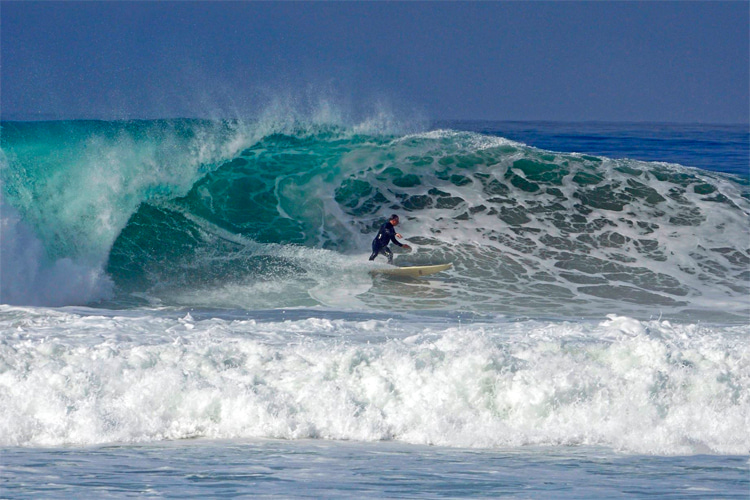
The Surf Zone
The submarine canyons amplified the size and energy of a wave as it approached the shore, resulting in spectacular and terrifying waves during certain swells.
These swells usually originated thousands of miles away in the Bering Sea.
A big set rolled through as we watched, and the waves appeared to break in slow motion as they rose, crested and then crashed into the shallower water.
Jonny and I looked at each other. His eyes spoke volumes. It was serious out there in the lineup.
These were menacing, top-to-bottom barrels that broke boards and bodies, so it was critical to be on top of your game when jousting with them.
A few years earlier, I had helped pull a body out of the water on a big day here with Doc Bracker, full of water and empty of life.
It took more than mere surfing competence to skillfully handle the big sets that rolled through South Peak on a big northwest winter swell.
These were the days that few surfers paddled out, and even fewer actually stroked into the behemoth set waves.
We watched a couple of sets roll through with just a few takers and Scripps Pier and the Mushroom House serving as sea-misted backdrops.
La Jolla Cove and Boomer Beach bodysurfing reef were visible in the distance beyond the pier, both showing the effects of the huge northwest swell.
"Let's suit up..." said Jonny.
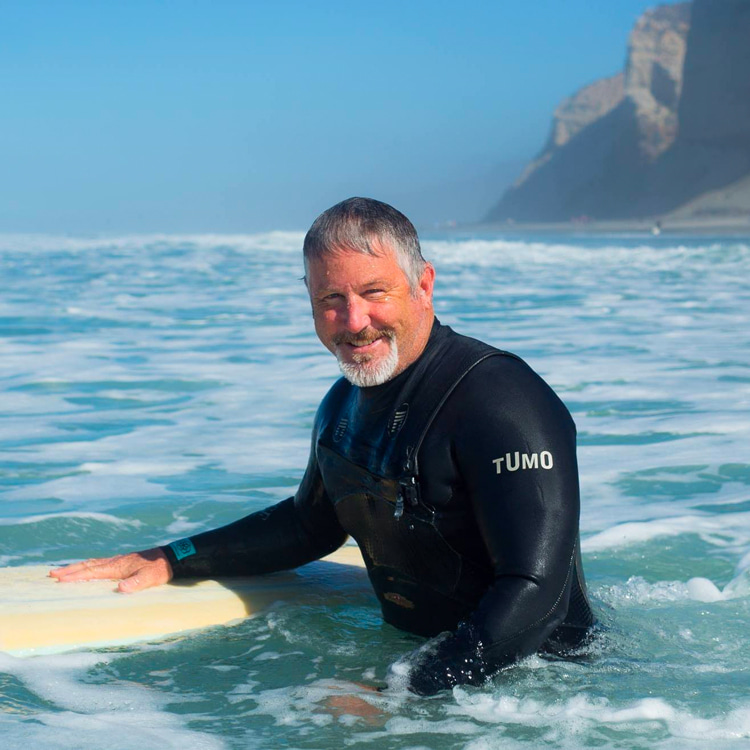
Getting Mentally Ready for Armaggedon
We pulled on our damp wetsuits in the brisk January morning air, focused on the task, each lost in our own reverie, contemplating the battle to come.
On days like this, the conversation was subdued, unlike the jovial banter which accompanied smaller days.
The waves continued to pound all up and down the beach, echoing off the steep sandstone cliffs that ran along most of the beach.
One could feel the detonations of the larger ones. Waxing our boards and checking our leashes, we were in no rush to get to the water's edge.
Surfing big waves requires as much mental preparation as physical.
It was important to be in the right frame of mind from the outset, as things could go sideways quickly in fast-moving water.
Equipment needed to be looked over more carefully than normal - proper board selection, fins, wax - and, of course, the leash, which tethered a surfer to his board.
As we grabbed our surfboards and turned the last corner from the parking lot down to the beach, we saw that there were dozens of onlookers and photographers lined up in front of the cliffs, all mesmerized by the glory and carnage unfolding out in the water.
There was an excitement, a palpable buzz in the air.
Great shouts and murmurs ran through the crowd each time someone had a nice ride on a wave.
And louder still was the crowd when a surfer did not make the wave and was annihilated by the thundering whitewater.
Ego, Big Ty, and JR sat on a rock just a few yards from the high tide mark, studying the melee unfolding before them - boards at their feet, waxed and ready to join the fray.
These were regular surfers at this spot and no strangers to its power and vicissitudes.
They, too, appeared to be approaching the upcoming surf session with an abundance of reflection and caution.
"How is it?" asked Jonny.
"We're just watching it," said Ego.
We all watched a larger-than-average set clean up most of the surfers, who had not seen it coming on the outside.
There were boards and bodies rolling everywhere in the huge white wall of churning foam as it raced toward the beach.
Jonny spun and looked at us.
"You all live here," he said. "Let's go!"
Nothing more needed to be said. Though all of us surfed this break on a daily, Jonny was the "mayor."
Not only was he one of the most fearless surfers in the water, but he also gave the university funds needed to maintain the gate and the road that led down to our beloved surf spot.
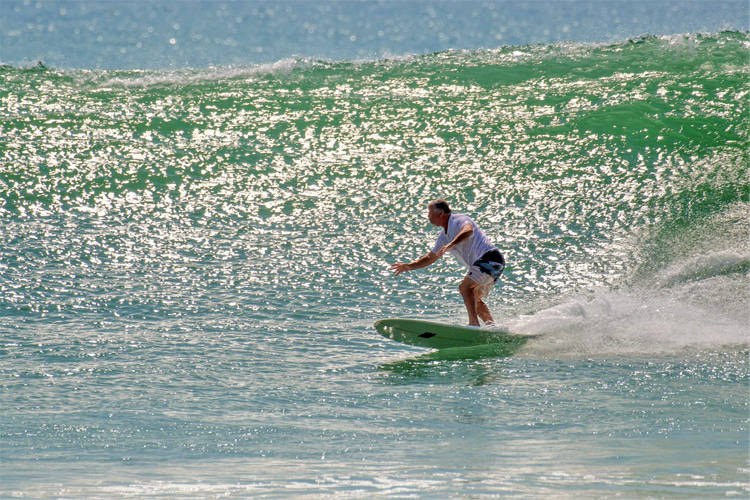
Paddling Out
We all gathered up our boards and began to walk south towards the Mushroom House (so named for its unique shape), as that was the only possible place to make a safe entry into the water and paddle out into the lineup.
Another monster set crashed on the outside, and we walked along in silence.
Once at the Mushroom House, we put our boards down on the sand and began stretching.
For some, this was a cursory exercise in limbering up. For others, it was a time to really stretch out taught muscles - and to reflect and pray.
I belonged to the latter group.
It was important to me to stretch vigorously before every surf session and on a day like today to really reflect - and pray.
Big Ty was the last one on the beach with me.
He was watching the others as they paddled through the whitewater and chose their path (and timing) through the ever-increasing phalanxes of waves.
Thus far, they had encountered some bigger sets but nothing overly large.
"You ready?" asked Big Ty.
"I guess..." I replied less than enthusiastically.
We watched as Ego, JR, and Jonny paddled over a big gray-green wall of water and disappeared.
"Let's do it!" he said and ran to the water.
We both walked out until the water was chest-deep and then began to paddle.
Things were eerily quiet except for the sound of crashing waves and my heart beating in my ears.
In the winter, we wore earplugs to keep the cold water out in order to prevent surfer's ear - a bony growth inside the ear canal, which the body uses to protect the inner ear from the elements.
But the earplugs had the effect of amplifying your heartbeat and your breathing.
So much so that during extreme exertion, the inside of your head sounded like the soundtrack for a slasher movie.
Big Ty had a much longer reach than I did, so he easily pulled away from me with his powerful strokes.
I worked to keep on his tail as I trusted his judgment as to the path of least resistance to the outside.
We duck-dove under many smaller, inside waves.
Duck-diving is a maneuver wherein a surfer rises up off his board and then pushes the nose of his board down sharply in order to try and slip beneath a breaking wave.
This technique works up to a point.
But after that point, the size of the wave dictates that the surfer abandon his board by either pushing it rapidly up the face of the wave (and hoping that it makes it over) or pushing the board back toward the beach and diving as deep as possible before impact.
Neither of these two options is appealing in the least and essentially indicates that a major drubbing is imminent.
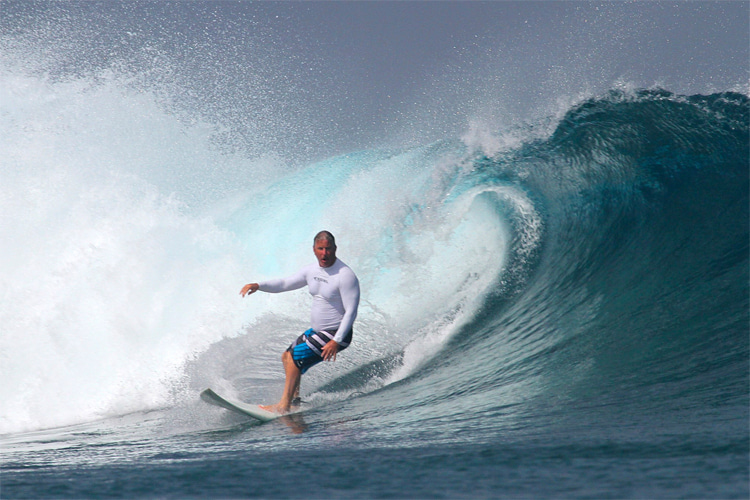
The Impact Zone
After wending our way through the inside wave section, Big Ty and I began to move cautiously through the impact zone.
This is the area where the majority of waves break on any given day, so there is a lot of water and energy contained here.
It takes years to successfully learn to navigate the impact zone, using all of the tools available to the waterman - paddling faster, paddling slower, paddling sharply left or right, duck diving.
The key is the accrued knowledge of hydrodynamics and bathymetry earned over many seasons and many paddle-outs put to use in the most efficient manner possible.
Some surfers make it look effortless, but that apparently easy paddle from the beach to the outside has taken them a lifetime of practice and learning.
At long last, we made it through the impact zone, and Big Ty throttled back a bit so I could catch up.
"You good?" he asked.
"All good," I replied, breathing heavily.
He began paddling again toward the outside, angling to the north a bit where the main takeoff spot was located.
I sucked in a few more deep draughts of sweet air and began to paddle after him.
He was keeping a leisurely pace, and I happily kept the same pace, perhaps 15 or 20 feet behind him.
My second wind was now kicking in, and the effort to paddle seemed less taxing, as when a marathoner hits stride and falls into a rhythm.
We paddled up and over many large walls of unbroken water - swells that would shortly be hitting the impact zone and breaking on the shallower sand bottom.
These swells were big, but because we were paddling up their faces and over their tops so early, there was no concern.
In fact, it was exhilarating to stroke up something the size of a two-story building, reach the crest, and then roll down the backside of the wave toward the next one.
Almost relaxing, if timed correctly, and the waves were all the same size, for you knew what to expect and fell into a metronome stroke.
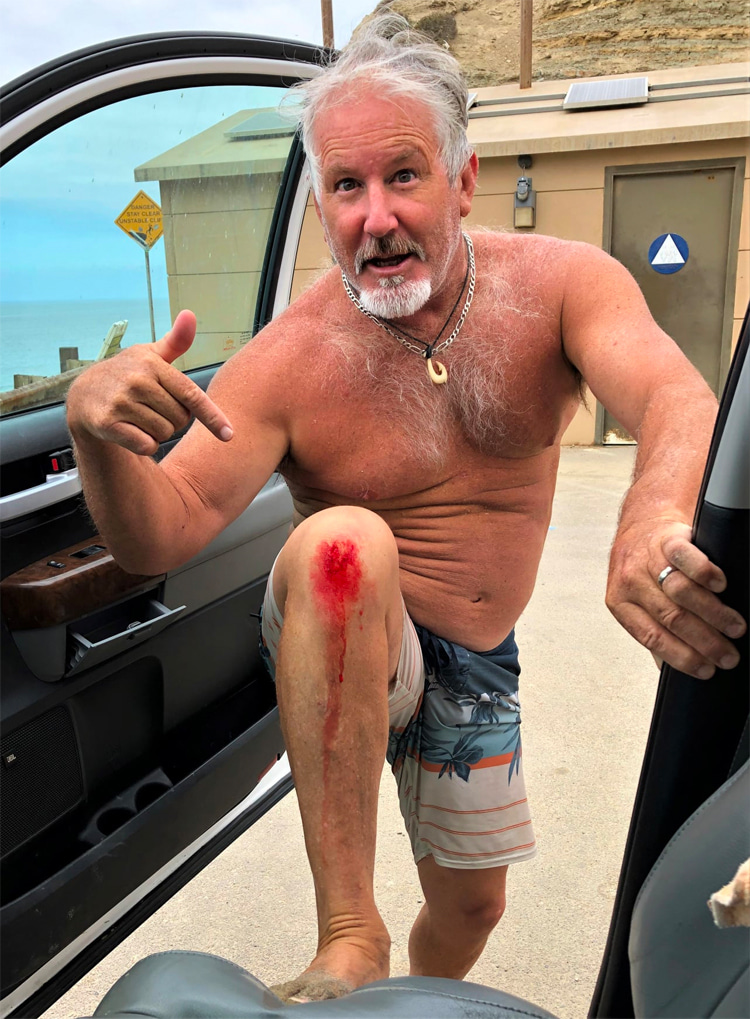
Freak Wave
Of a sudden, Big Ty - who had just reached the top of a wave in front of me - began to paddle faster. Much faster.
My heart rate quickened, and I began to paddle harder as well.
I had not reached the crest of the wave yet, but I was certain that what he had seen on the other side was not friendly.
When I reached the top, I instantly understood the reason for his accelerated pace - a much larger-than-normal set was bearing down on us from far outside.
These were canyon dwellers - the rogue sets that appeared out of nowhere and swept through the lineup at this beach and destroyed everything and everyone in their path.
Big Ty reached the flat area between the waves - the pit - and slowed just a bit.
He turned to look at me, still 20 feet behind him, and it was a look of genuine concern.
Not of fear, exactly, but his eyes conveyed the severity of what he believed to be racing toward us.
He turned and paddled harder than I had ever seen him paddle in my life.
I saw the huge wall of water coming at us, the spray whipping off the crest as it bore down.
It seemed almost angry as if it had traveled across the North Pacific with the sole intention of causing great distress and harm.
This wave was easily three stories high, far and away, the biggest wave we had seen since arriving at the beach.
I put my head down and paddled as hard and as fast as I possibly could.
Panic began to well up in my chest, and my throat and my breaths came in huge, rasping gasps.
I silently prayed to God to please let me live, ostensibly for my children, but in truth, out of sheer abject terror.
Big Ty was now halfway up the face of the first canyon dweller, and his 6'5'' frame looked like a small shadow on the side of a blue-green building.
He was scratching for all he was worth, and I was making for the base of the wave as fast as I could, but it was clear that I was not going to make it over the top.
Even Big Ty had only a 50/50 chance of clearing the hissing crest.
The panic within me overwhelmed my senses, and I began to sob. Time slowed to a crawl, as it does when adrenaline and fear take over.
There was no sound, not even the sound of my breathing or my heartbeat.
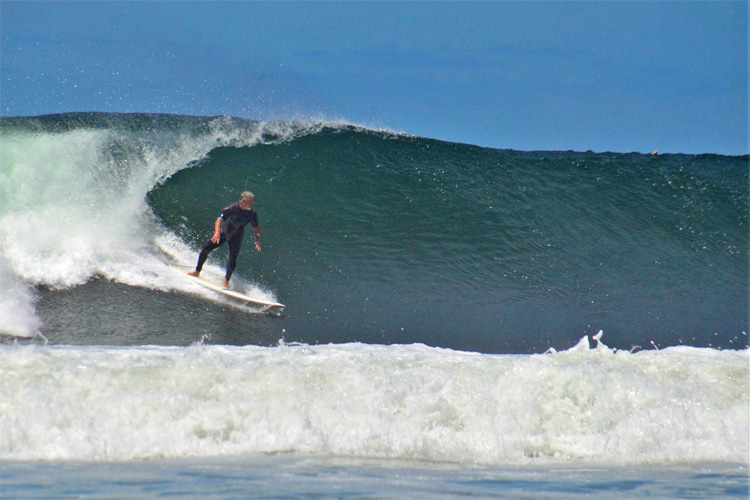
Waving Goodbye
The wave loomed unimaginably large in front of me.
I was in the pit between waves and had to crane my head far back in order to take it all in.
I sobbed and stroked as if my life depended on it - which may or may not have been the case.
I was prepared for the worst but did not give up and kept paddling as hard as I could.
And then I looked up again from my paddling, and the most outrageous and amazing thing happened.
Big Ty had somehow clawed to the very peak of the wave. I was in the shadow at the very bottom, the wave itself blocking out the sun.
And then Big Ty turned around and looked down at me - a good 25 feet between us - and the look of concern that had been on his face melted.
And he stopped paddling just as he hit the very zenith of the wave and a huge smile broke out on his face.
A smile!
Then his right hand came up, and he ever-so-slowly waved at me! And not just any wave - he gave me the classic bye-bye wave.
A cartoon wave. Grinning like a Cheshire cat and giving me the wave as he disappeared from view over the back of the wave.
Buh-bye, now.
It was just so patently absurd and hilarious and casual that I just stopped paddling.
And while still acutely aware of my immediate situation, I began to laugh. And the panic subsided.
I knew that I was about to get pummeled within an inch of my life by the Pacific Ocean and that things might get really ugly in the next few moments.
But I was good with it. Big Ty had made everything alright with a simple smile and the wave.
I rolled off my board and took a huge breath as the lip of the wave came down at me from high over my head.
It was readily apparent that this was going to be the worst thrashing I had ever had in my life.
I dove as hard and as fast as I could for the bottom. But I was still smiling.
Words by C. K. Littlewood | Senior Loan Officer and Surfer
